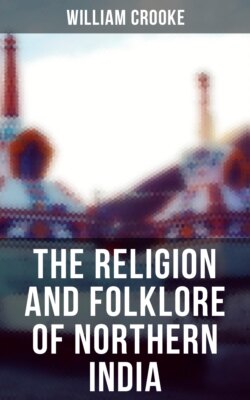Читать книгу The Religion and Folklore of Northern India - William Crooke - Страница 87
На сайте Литреса книга снята с продажи.
Minor Disease Godlings.
ОглавлениеTable of Contents
There are a number of minor disease godlings, some of whom may be mentioned here. The Benares godling of malaria is Jvaraharîsvara, “the god who repels the fever.” The special offering to him is what is called Dudhbhanga, a confection made of milk, the leaves of the hemp plant and sweetmeats. Among the Kols of Chaibâsa, Bangara is the godling of fever and is associated with Gohem, Chondu, Negra and Dichali, who are considered respectively the godlings of cholera, the itch, indigestion and death. The Bengâlis have a special service for the worship of Ghentu, the itch godling. The scene of the service is a dunghill. A broken earthenware pot, its bottom blackened with constant use for cooking, daubed white with lime, interspersed with a few streaks of turmeric, together with a branch or two of the Ghentu plant, and last, not least, a broomstick of the genuine palmyra or cocoanut stock, serve as the representation of the presiding deity of itch. The mistress of the family, for whose benefit the worship is done, acts as priestess. After a few doggrel lines are recited, the pot is broken and the pieces collected by the children, who sing songs about the itch godling.18
Some of these godlings are, like Shashthî, protectors of children from infantile disorders. Such are in Hoshangâbâd Bijaysen, in whose name a string, which, as we shall see, exercises a powerful influence over demons, is hung round the necks of children from birth till marriage, and Kurdeo, whose name represents the Kuladevatâ, or family deity. Among the Kurkus he presides over the growth and health of the children in three or four villages together.19 Acheri, a disease sprite in the Hills, particularly favours those who wear red garments, and in his name a scarlet thread is tied round the throat as an amulet against cold, and goitre. Ghanta Karana, “he who has ears as broad as a bell,” or “who wears bells in his ears,” is another disease godling of the Hills. He is supposed to be of great personal attractions, and is worshipped under the form of a water jar as the healer of cutaneous diseases. He is a gate-keeper, or, in other words, a godling on his promotion, in many of the Garhwâl temples.20
Among the Kurkus of Hoshangâbâd, Mutua Deo is represented by a heap of stones inside the village. His special sacrifice is a pig, and his particular mission is to send epidemics, and particularly fevers, in which case he must be propitiated with extraordinary sacrifices.21
One of the great disease Mothers is Marî Bhavânî. She has her speciality in the regulation of cholera, which she spreads or withholds according to the attention she receives. They tell a curious story about her in Oudh. Safdar Jang, having established his virtual independence of the Mughal Empire, determined to build a capital. He selected as the site for it the high bank of the Gûmti, overlooking Pâparghât in Sultânpur. And but for the accident of a sickly season, that now comparatively unknown locality might have enjoyed the celebrity which afterwards fell to the lot of Faizâbâd. The fort was already begun when the news reached the Emperor, who sent his minister a khilat, to all outward appearance suited to his rank and dignity. The royal gift had been packed up with becoming care, and its arrival does not seem to have struck Safdar Jang as incompatible with the rebellious attitude which he had assumed. The box in which it was enclosed was opened with due ceremony, when it was discovered that the Emperor, with grim pleasantry, had selected as an appropriate gift an image of Marî Bhavânî. The mortality which ensued in Safdar Jang’s army was appalling, and the site was abandoned, Marî Bhavânî being left in sole possession. Periodical fairs are now held there in her honour.22
